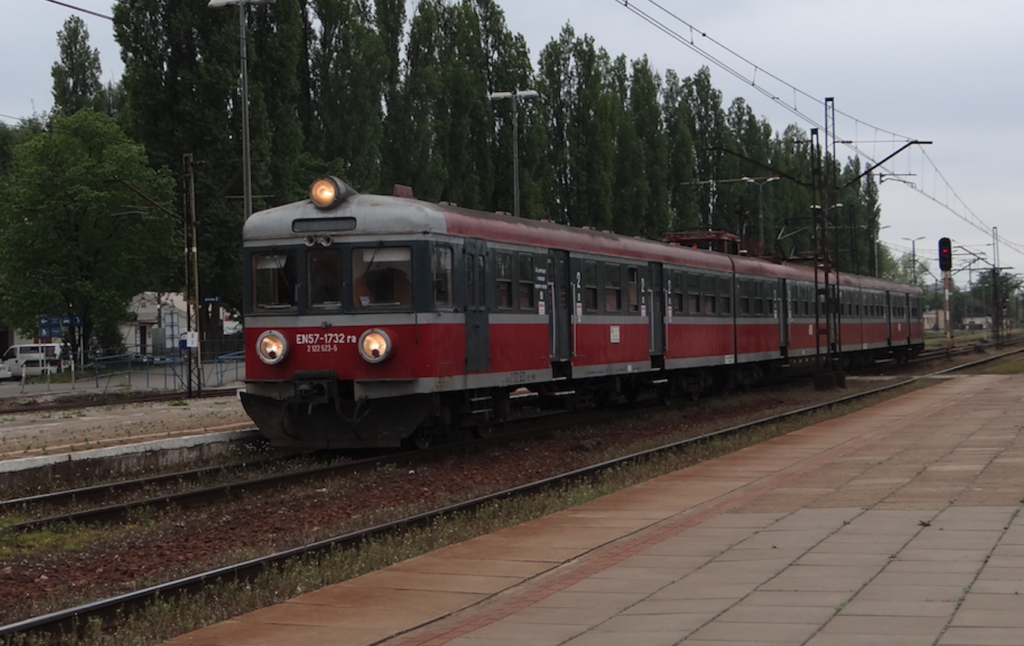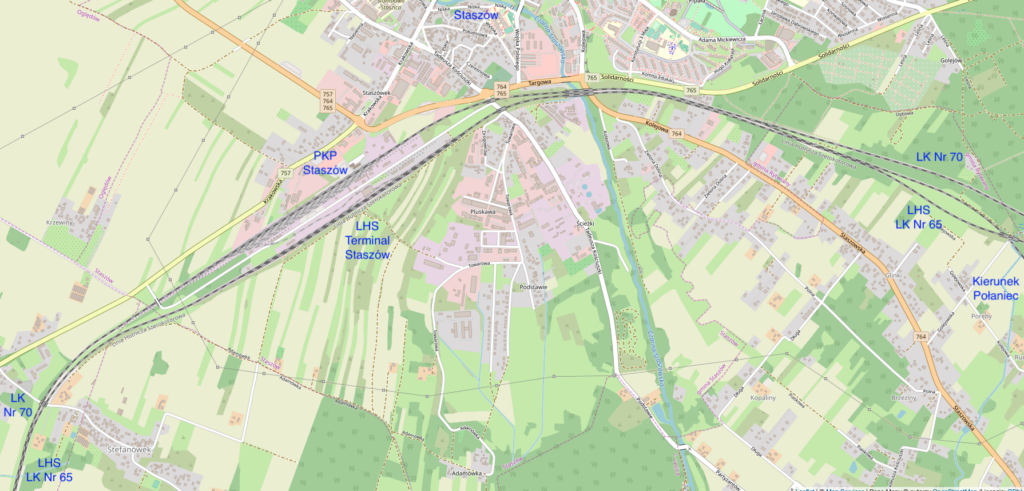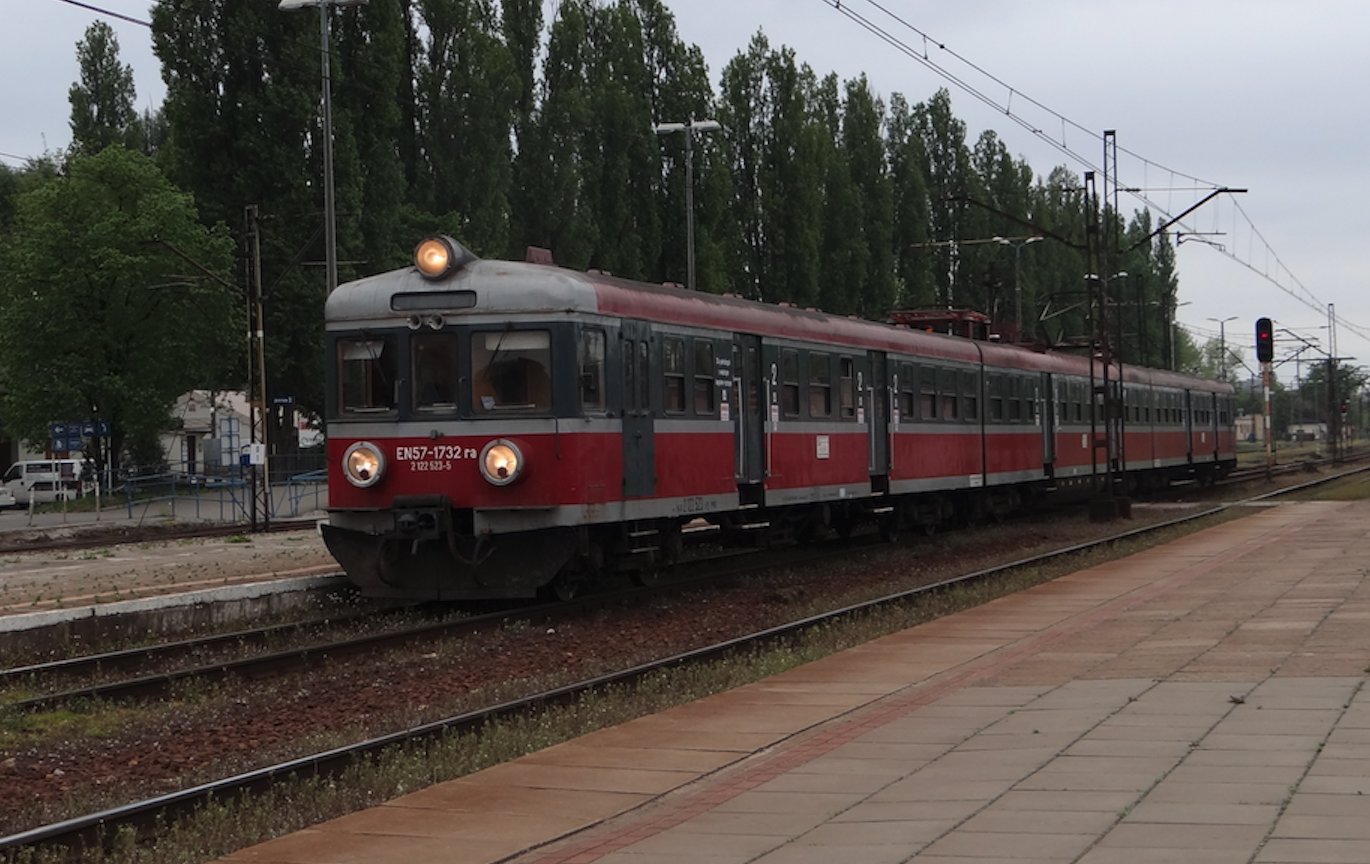Staszów 1-05-2025
Staszów Railway Station.
Geographic coordinates: 50.550N 21.156E. Elevation 194 m.


Staszów is a city located in southeastern Poland, in the Świętokrzyskie Voivodeship, the seat of the Staszów County and the Staszów urban-rural commune. The Czarna Staszowska and Desta rivers flow through the city.
The first mentions of Staszów date back to 1241, when the village was burned down by the Tatars. In 1525, thanks to Hieronim Łaski, the town obtained city rights and became a private noble town. Over the centuries, Staszów passed through the hands of various owners, including the Opaliński and Czartoryski families. In the 18th century, the city was an important trade and craft center. Staszów has preserved its medieval urban layout with a market square and a town hall in the middle. The most important monuments include the 14th-century church of St. Bartholomew, which has been rebuilt several times. The city also has 18th and 19th-century tenement houses and a town hall from 1783. In 2025, Staszów celebrated the 500th anniversary of granting city rights.
According to data from 2023, Staszów had 13,680 inhabitants. The city covers an area of 26.88 km2 and is divided into several settlements, including: Stare Miasto, Golejów, Radzików and Pocieszka.
Staszów is located in southeastern Poland, in the Świętokrzyskie Voivodeship, in the central part of the Sandomierz Upland. It is located: 57 km south-east of Kielce (the capital of the province), 51 km south-west of Sandomierz. Distance from Staszów; It is 70 km to Tarnów, 116 km to Krakow, 208 km to Warsaw. The city’s elevation is between 180-210 m. The city lies on the Czarna Staszowska River, a tributary of the Vistula. The city is surrounded by a hilly landscape, characteristic of the Świętokrzyskie Uplands. The areas around the city are mainly forests, farmlands and small hills. In the area there is the Świętokrzyska Forest and the Chańcza Reservoir, which is a popular recreational area.
Railway in Staszów.
The Staszów region is an area that is exceptionally neglected in terms of transport, which was caused by the Muscovites, because the area was under their rule. Even in the times of the Polish People’s Republic, the network of roads and railway lines was not developed much. Also in the 21st century, subsequent governments were not interested in developing transport in this part of Poland.
The narrow-gauge railway in Staszów was an important element of the local transport infrastructure for over 70 years. Its history dates back to the Great World War, when in 1915, the Austro-Hungarian army began building a narrow-gauge line, with a track width of 600 mm, initially as a field railway. In 1917, the Bogoria – Staszów – Jędrzejów section was completed.
The Staszów Narrow-Gauge Station was part of the Jędrzejów Narrow-Gauge – Szczucin line near Tarnów Narrow-Gauge, which reached a length of 137 km. In 1953, the line was converted to a 750 mm gauge track. The railway was used for both passenger and freight transport, serving local communities and industry. The last passenger train ran from Bogoria to Staszów around 1990, after which the railway was liquidated. Currently (2025), there are few material traces left of the former narrow-gauge railway in Staszów. All the collected memorabilia from this railway can be seen in the Museum of the Staszów Region. For lovers of the history of narrow-gauge railways, the tourist railway “Ciuchcia Ponidzie” still operates in the Świętokrzyskie region, running on the Jędrzejów – Pińczów route. Although it does not include Staszów, it offers the opportunity to experience a journey by historic train in picturesque scenery.
Railway line No. 70 Włoszczowice – Chmielów.
Railway line No. 70 Włoszczowice – Chmielów was one of the few completed railway lines, which was to equalize the railway system in Poland, after World War II. The line was to relieve the main railway routes by creating alternative routes. Line No. 70 was put into operation in stages. On July 19, 1969, the Włoszczowice – Grzybów section was launched, on May 31, 1972, the Grzybów – Staszów section, on September 20, 1973, the Staszów – Chmielów section. The name of the line changed due to the change of the name of the final station. The previous name of the line was Włoszczowice – Chmielów k/Tarnobrzeg.
From the very beginning, the electrification of railway line No. 70 was planned. Electrification with 3 kV DC current. In reality, electrification took place a few years later. On November 26, 1988, the Włoszczowice – Rytwiany section was electrified, and on December 21, 1989, the Rytwiany – Chmielów section was electrified.
Line No. 70 is 88.137 km long. The line runs meridionally. Currently, the maximum speed of trains is 60 km/h. Passenger traffic was carried out until 2013. One of the last trains was the Przemyśl – Wrocław and Wrocław – Przemyśl train. Currently (2025) there is no passenger traffic on the line.
The line was used to transport, among other things, sulfur from the mine in Grzybów. When the mines were closed, part of the station in Grzybów was liquidated, as well as part of the railway infrastructure at the Raczyce, Chodków and Nagnajów stations.
From 2022, the revitalization of railway line No. 70 was considered. This was the program “Increasing the capacity of selected railway lines by optimizing traffic control devices and station systems”. On April 17, 2024, the tender for the performance of part of the planned works was resolved. The line is planned to increase the speed of passenger trains to 100 km/h. In 2025, under the new government in Poland, a declaration was made to increase the speed to 120 km/h. In fact, the previous tender was canceled and the works were suspended. The idea was to keep it as it was, i.e. to prevent passenger trains from returning to line No. 70. In 2026, the construction of a transshipment terminal is planned at the Grzybów and Grzybów LHS stations, the contractor will be Mirbud.
Włoszczowice station (0.00 km, elevation 267 m), start at line No. 73. Chmielnik station (13.65 km, elevation 258 m). Raczyce passing place (24.78 km, elevation 210). Grzybów station (39.81 km, elevation 220 m). Staszów station (49.35 km, elevation 200 m), next to it is the LHS station, railway line No. 65. Rytwiany post (51.58 km, elevation 199 m), railway line No. 75. Strzegomek station (62.58 km, elevation 201 m). Osiek Staszowski passenger stop (70.43 km, elevation 181 m). Stary Łężek loading room (80.22 km, elevation 151 m). Świętokrzyskie / Podkarpackie provincial border (82.67 km). Nagnajów outpost (84.55 km, elevation 167 m), railway line No. 70a. Chmielów station (87.11 km, elevation 161 m), railway line No. 25, 933.
Standard gauge railway station Staszów.
Staszów railway station has a station building put into operation in 1980. The station was opened on May 27, 1972. On that day, the first passenger train from Kielce arrived in Staszów. The SM42 locomotive, plus two 43A Ryflak type cars. After electrification, EN57 type trains arrived in Staszów. According to the unanimous opinion of the residents of the Staszów area, the route was marked out incorrectly. The main disadvantage was the location of the station and passenger stops at a considerable distance from the center of cities and villages.
At Staszów station there are two platforms and three platform edges. Platform 1 is single-edged and is located next to the station building and is 250 m long. Platform 2 is an island platform with two edges and is 293 m long. There are 6 bus shelters, benches and waste bins on this platform. Currently (2025) the shelters are destroyed. There are 12 lanterns on the platform. The surface is made of pavement tiles, but it is currently overgrown with grass and weeds.
The station was put into use only in 1980, as a PKP and PKS (State Car Transport) building. The building is two-storey. The building had a waiting room, train and bus ticket offices, a RUCH kiosk, a bar and a student recreation room. There was a taxi rank and a food kiosk on the station square. At that time, the station served 200-300 passengers daily.
On the southern side of Staszów station there is a station and LHS terminal. In the vicinity of Staszów, the No. 70 railway line runs parallel to the LHS No. 65 railway line.
In 2000, the first major cut in rail connections took place. The connections were set up in a way that was disadvantageous for passengers and their number was limited. It became impossible to take a train to Kielce, settle a matter at the office and return the same day. Passengers were left with PKS connections. However, in 2009, the Staszów station was also abandoned by the local PKS branch. All service and commercial points in the station building were closed. The building was locked with all possible padlocks.
During the rule of the United Right, there were plans to improve the rail system in Poland and eliminate social exclusion. For residents of Staszów and other towns, two options were offered to reach the CPK (Central Communication Port). The first option was to reach Stalowa Wola and travel on spoke No. 6 or to reach Busko Zdrój station and travel on spoke No. 7. However, after the Masons, Volksdeutsche and communists came to power in 2023, all plans were thrown into the trash. Even small plans for the Busko Zdrój – Żabno – Tarnów and Połaniec – Mielec connection did not survive.
In 2024, a special train traveled through railway line No. 70 and others. The organizer was Railway Tourism TurKol. The following companies joined the organization of the journeys: PKP InterCity, PKP Cargo, SKPL and RaiPolska. The train was assembled from a historical locomotive and passenger cars. Route; Połaniec, Tarnobrzeg, Stalowa Wola, Biłgoraj, Zamość, Hrubieszów Miasto, Przeworsk, Rzeszów, Jasło, Sanok, Łupków, Uherce Mineralne, Kraków, Wadowice, Andrychów and Chabówka. This was the longest route. There were also shorter journeys, for example; Staszów – Połaniec – Staszów.
The authorities of the city of Staszów and other towns (Oleśnica, Rytwiany) still want to revive passenger traffic on line No. 70. There are plans to build a transfer center. According to the plan, parking lots and bicycle paths would be built around the station. The estimated cost is PLN 20 million. The first plans would be to buy the station building in Staszów. There was a proposal to buy it for 20% of the value, and 80% would be a donation. The authorities of Staszów want to apply for funds for the implementation of the project from the Regional Operational Program of the Świętokrzyskie Voivodeship. To launch the Kielce – Staszów connection, it is necessary to spend PLN 11 million and PLN 4 million for the Kielce – Połaniec connection. The problem is complicated because lines No. 70 and 75 are single-track routes and each renovation causes a complete closure of traffic. The works must be carried out in stages, sections 5-8 km long. The current works (2025), which are carried out by PKP PLK, consist in maintaining the trafficability of the routes.
Written by Karol Placha Hetman
